The Labour Party posted ( mirror ) its 2021 accounts to the Electoral Commission site earlier this week. The papers, the Independent and the Guardian rapidly picked this up. They and Labour List focused on the first deficit in years and the loss of 91,000 members. I look at the numbers and and add the observation that individual donations are very weak, and donations as a whole remain dominated by Trade Union donations.
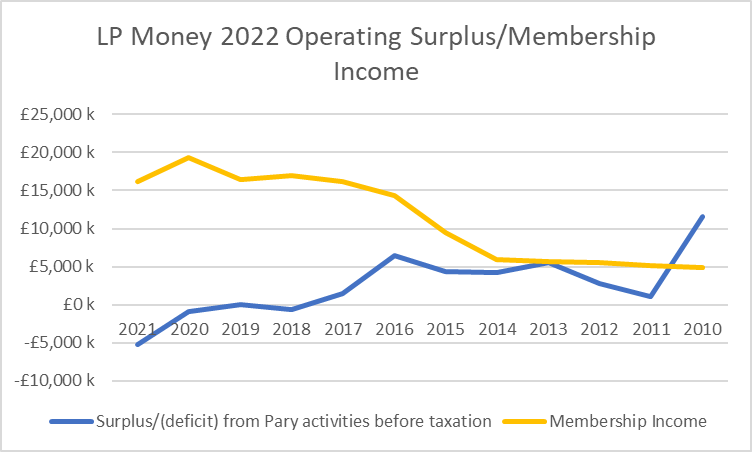
They were followed a day later by the Forensic Socialist who published (or my mirror) a presentation on twitter. Esther looks at the decline in membership and membership income, the reduction in net assets, i.e. the best measure of liquidity, the increase in running costs, including a strange and unexplained £6m item & the operational deficit, which was only transformed into a balance sheet surplus by a pension fund re-evaluation. She estimates that if Labour continues to spend like this it’ll be bankrupt (or need bank loans in 18 months).
Income
Income was £45½m which is just under £4m less than 2020, most of this reduction was due to the reduction in membership fee income which was £3.1m lower than 2020. Donations were up from a very low number in 2020, but have become dominated by trade union donations. Membership income is projected to fall further in 2022, this is based on informal surveys, we know that people have been leaving in 2022 and those that left in 2021 without resigning will still be assessed as in membership on 31st December 2021.
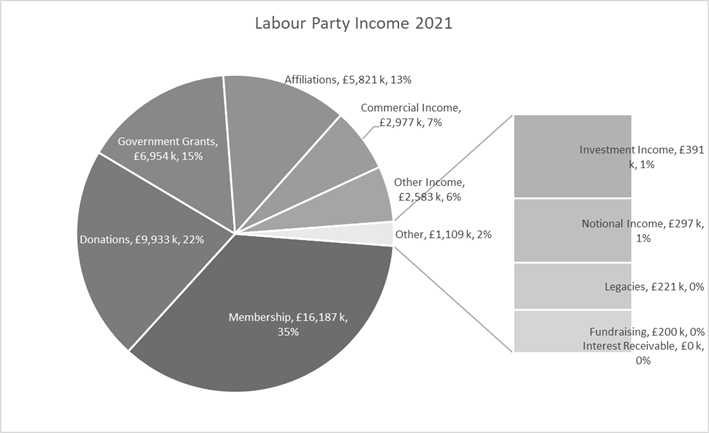

Donations
I also looked at donations which are available on the EC site (my version) . The rich donors are not yet coming through and the total individual donor level is pretty low. The Trade Unions are once again the single largest category of donations contributing over 70% of the donation income. Of the individual donations , over half of the cash donated came from two people. I wonder if Unite (£1.7m), CWU (£500k) & GMB (£1.3m) will continue to pay at this rate.
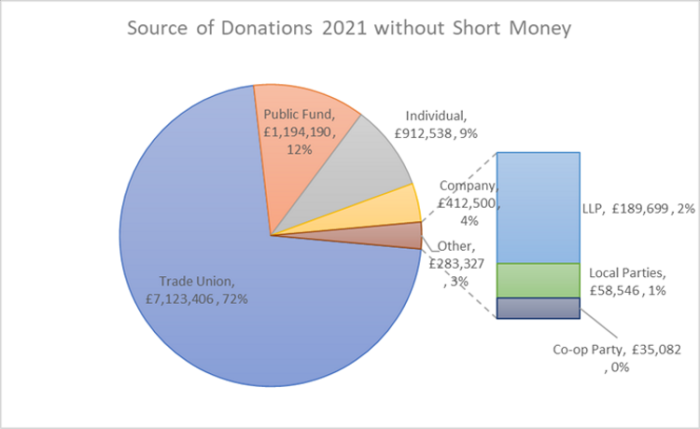
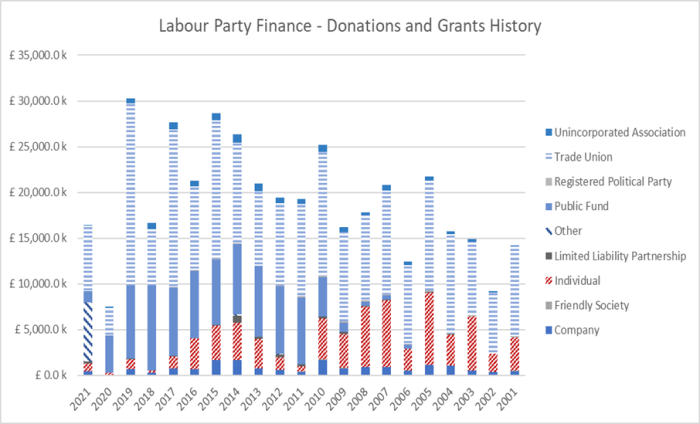
For these charts I have removed three trivial classes to make the charts easier to read.
Blair’s Labour Party raised over £7m in individual donations in 2005 & 2007 and even they run out of money to fight elections. Last year’s individual donations was under £1m with as already noted half of that coming from two people.
Also the Electoral Commission changed the way in which they classified Short Money and other public grants to the party. Ideally these should be removed from the chart above but disentangling the Short Money itself from the other grants would require going back to the base figures over the 11 years. The Labour Party accounts show the public grant income as a single budget head separate from donations. The electoral commission have it seems moved the Short Money from Public Funds to Other. Does the electoral commission have a minimum threshold for reporting?, How does the party account for such donations?
Expenditure
Expenditure was the highest ever, dominated by running costs (80%) which are up by £5.2m and dominated by staff costs.
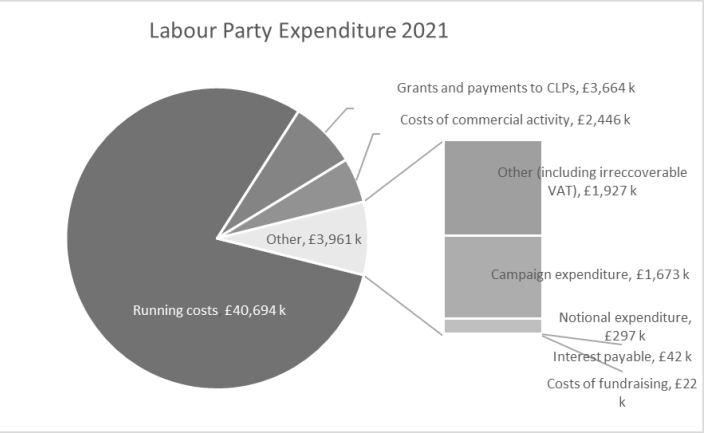

It would be curious to know how much of the staff costs are recurring or can be expected to not be incurred in FY 22. How much were the redundancy payoffs, how much spent on contractors (on time limited contracts) vs staff, how much on 3rd party consultants inc. lawyers? This increase in staff costs was despite the average number of employees being down by 10% (40 employees). It’s clear that the contractor cost of staff in Legal and Governance Unit, currently employed in searching for and expelling members and ex-members of Socialist Appeal and the AWL together with members and ex-members of the LLA; meanwhile bullying is ignored. Do the reported staff numbers include short term contractors? It is also noteworthy that the senior management team costs increased by £347K; this should be explained.
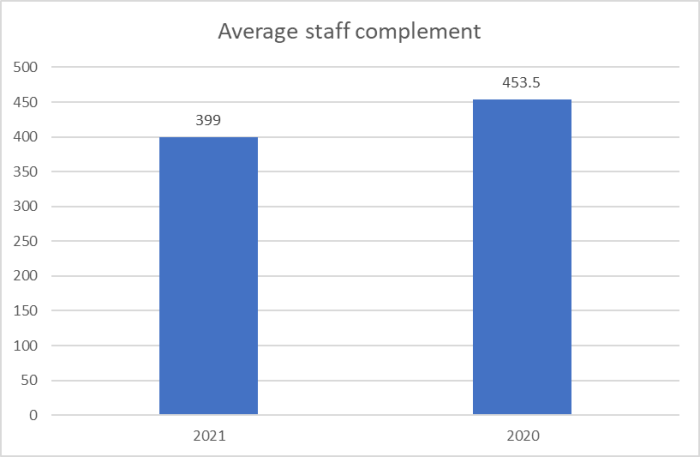
There is a £6m item called political activities and publication, this was trivial in 2019 and jumped to £3m in 2020 and £6m in 2021 i.e. since Starmer became Leader and Evans became General Secretary.
I note that in this year’s annual report, the General Secretary is declared as the Treasurer, I can’t imagine that’s acceptable to the bank. The report says,
The Registered Treasurer of the Party is required by the Political Parties, Elections and Referendums Act 2000 to prepare financial statements for each financial year which give a true and fair view of the state of affairs of the Party and of its surplus or deficit for that period. In preparing those financial statements, the Registered Treasurer is required to:
Labour’s Annual Financial Report to the ELECTORAL Commission
• Select suitable accounting policies and then apply them consistently;
• Make judgements and estimates that are reasonable and prudent;
• State whether applicable accounting standards have been followed, subject to any material departures disclosed and explained in the financial statements; and
• Prepare the financial statements on the going concern basis unless it is inappropriate to presume that the Party will continue in business.
The Registered Treasurer is responsible for keeping proper accounting records which disclose with reasonable accuracy at any time the financial position of the Party at that time and to enable him to ensure that the financial statements comply with the Act. He also has delegated responsibility from the National Executive Committee for ensuring that appropriate controls are established for safeguarding the assets of the Party and hence for taking reasonable steps for the prevention and detection of fraud and other irregularities.
I’d like to see and examine the IT Risk Controls and learn how often their effectiveness and coverage is reviewed. The last bank I worked for did this every 3 months.
CLP grants have fallen £900K, this is a slight fall in the grant to membership income ratio. This can be impacted by a number of things. The basic grant is based on a fixed rate payment/member. These payments will be supplemented by development grants. The membership income will depend on the number of members and the number paying a reduced fee, the average fee paid is 7!% of the full rate. It might be interesting to learn how much of this expense item is discretionary. The mandatory component is about 5% of the full rate fee, so there’s possibly some question to ask and answer about how much is discretionary and how and where it’s spent.
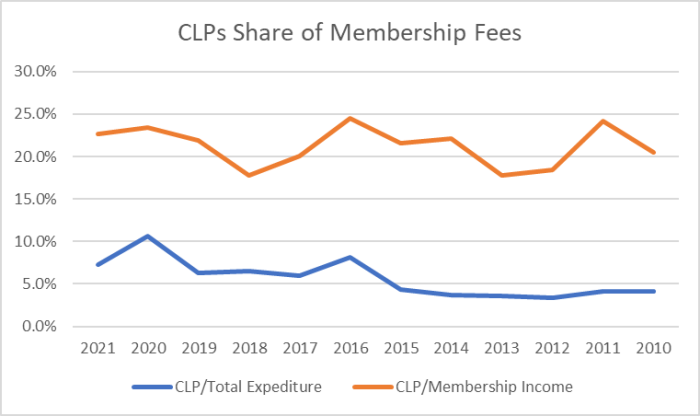
Net Assets
Here is my version of the net assets position chart, showing a 2019 peak.
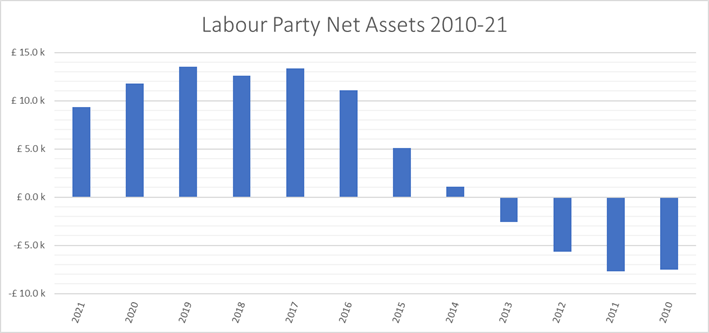
I finish this review by quoting Esther,
We have seen that the most material component of income to the Party is membership income, which increased by more than 300% (£13m) between 2015 and 2020. Now this income is on the wane, with a reduction in 2021 of £3.1m, with further reductions to come.
Running costs are at an all-time high at £40.1m. The extent to which these costs include non-recurrent severance costs should be clarified. The Party must reduce its running costs in order to bring the finances into balance.
Should the Party continue at its 2021 running costs, but with income decreasing as set out above, the Party would run out of reserves within two years
All of the above analysis is based on figures provided in the 2021 accounts and the published donation datasets. NEC members will have access to 2022 figures, but these are closely guarded. Some NEC members say they do not have access to comprehensive and understandable financial data-.
Esther Giles – “”
Questions
Is there a plan to eliminate the operating deficit?
What is the projected annual surplus/deficit for 2022?
Is there a reserve policy and is the Party meeting it?
Are all donations reported to the EC? i.e. is there a donation threshold that allows donations to not be reported? If so does the Party report everything to the EC? If not where does this money appear on the accounts?
How often and in what detail are party expenses reported to the business committee and the NEC?
How much of the staff costs are recurring and how much can we expect to be able to avoid in 2022? i.e. how much
Given the reduction in staff numbers, why is the staff cost so high?
What is political activity and publishing?
Why has the senior management team costs risen so high?
Are any members of the SMT on personal service contracts?
Of the CLP grants how much of this is discretionary as opposed to mandated by the rule book.
Have you reserved and if so how much for either fines or compensation payments as a result of the cyber-attack?
ooOOOoo
Featured Image: from flickr CC GotCredit 2017 BY
Great stuff, Dave. One of the questions I’ve asked (of the Party Treasurer) is about the Party’s Reserves policy. It’s not referenced in the accounts, and yet I would expect that the NEC would want to pay attention to it.
I’ve also asked the General Secretary to provide the schedule of delegation for the authorisation of spending. I’ve had no answer to this after nearly two years. This is a key issue when unbudgeted spend is incurred.
Both of these issues raise concerns about governance.
Finally, it seems clear to me that the overspend in 2021 was deliberate. Severance costs were no doubt budgeted, and the “political activities and publishing” cost of £6m was undoubtedly a spend incurred by choice.
Pingback:Labour party ‘bankrupt within 2 years’ on current financial course – SKWAWKBOX
Andrew Fisher comments on Labour’s finances. Her uses the same number’s I have yet adds two extra insights. He states Labour have lost another 50,000 members since the the turn of the year taking another £1.7m worth of fees with them. Fisher also quantifies the further reductions in staff down to 286 and the redundancy payments as £2.5m. However, without knowing the contractor costs and when and if they are temporary jobs that will end and thus stop requiring to be paid this isn’t helpful in knowing how much the running costs will naturally fall. It’s also necessary to know where in the accounts the cost of litigation is accounted for and whether this will decline.
Figure 3: Labour Party’s headcount 2022 – 2020
He also reports on the return in 2022 of rich individual donors; it may be so, but 2021’s individual donations were under £1m and even at the peak of my namesake’s activities from 2005 – 2008 where donations were over £5m p.a peaking at over £7m. The exception was 2006 which was the year that No 10 was investigated for illegal fund raising.
Figure 1: History of the sum of individual donations to the Labour Party
Fisher talks about funding an election and he and Skwawkbox are missing some important facts. The 2019 election cost Labour £8m according to the Mirror, this is £3m less than Labour spent in 2017, when £11m was spent. In 2019, the Euro Parliament elections were also held but it doesn’t sound right that we spent £5m on the Euro’s so I might need to go back to the EC site to get the accurate numbers. i.e. the Mirror might be wrong. Yet in 2017, where some argue we were only thousands of votes short of a majority we spent £11m and ended the year with £1.4m surplus. This has always struck me as very odd. We know that money was diverted from agreed target seats to others but the fact that a surplus was made shows there was more money to spend in 2017 and the amount of money held as cash shows that more could/should have been spent in 2019. Fisher argues that the falling income and growing annual deficit is a threat to an effective general election campaign, although the loss of members is more important and not just for doorstep campaigining. The fact is there was more money to spend in both those elections. McNicol who was General Secretary and Treasurer in 2017 is understandable, but why was so little spent on the general election in 2019. It’s unlikely to malice! We can note that in 2019, the cash in hand grew by £6½ m.
Table 1: Surplus/Deficit, Cash and Campaigning Expense for the Labour Party
Figure 2: Chart of Surplus, Cash and Campaigning expense
When considering 2022, I wonder if they have reserved against any regulatory action or compensation due to the data breach?
Pingback:The Finance Report – davelevy.info
Pingback:Syndicating Labour’s Money 2021 – davelevy.info